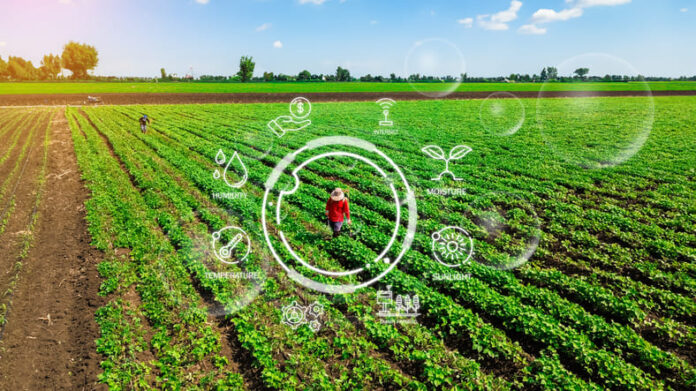By Indiana Lee
The agricultural industry must switch to a more sustainable business model in the face of climate change; climate-resistant farming, reduced carbon reliance, and introducing smart technology are just a few of these measures. While this enterprise has challenges — many agribusinesses will have to completely alter their process — it offers benefits beyond environmental protection and legal compliance.
Agribusinesses are at a crossroads in the face of climate change. Investing in sustainable agriculture is vital for mitigating climate impacts while meeting the growing food demands of a changing world.
Shifting to more sustainable practices offers many benefits: these practices can ensure long-term viability, contribute to ecological health, and enhance food security by adopting innovative and environmentally friendly practices. This article will outline current agricultural challenges and explore strategies for sustainable agriculture that agribusinesses can implement.
Current Agricultural Challenges
Agriculture faces many intertwined challenges that threaten its productivity and long-term sustainability. Even among these countless threats, climate change stands out as the most dire, due to its far-reaching impacts and increasing severity. More frequent and dangerous weather and rising temperatures disrupt growing seasons and reduce crop yields. Droughts, floods, and unpredictable storms not only destroy harvests but also have a detrimental effect on soil health, leading to long-term agricultural degradation.
Resource scarcity compounds the aforementioned climate-related issues. Water shortages are increasingly prevalent. It is projected that by 2025, two-thirds of the global population could live under water-stressed conditions, according to the Food and Agriculture Organization (FAO). With agriculture accounting for about 70% of global freshwater use, the competition for this vital resource is escalating. In addition, soil fertility is declining due to the overuse of chemical fertilisers and pesticides, disrupting the delicate balance of soil ecosystems and rendering them less productive over time.
In addition, the agricultural sector must also grapple with economic constraints. Chaotic commodity prices can cause uncertainty for farmers, making planning difficult. Increased production costs — driven by rising energy costs and more stringent regulations — place additional financial pressure on farmers, limiting their ability to invest in sustainable practices. Coupled with the high costs of adopting new technologies or transitioning to organic farming, these economic factors can hinder the adoption of sustainable agriculture.
Social and political factors are crucial in shaping agriculture. In many regions, farmers need access to vital information, resources, and technologies that could enhance their productivity and sustainability. Moreover, political instability and poor governance can disrupt supply chains, further exacerbating food insecurity. Land tenure issues can also prevent smallholder farmers from investing in their land if they do not have secure ownership, leading to suboptimal agricultural practices.
Strategies for Sustainable Agriculture
Here are a few strategies for investing further in sustainable agriculture:
Integrate Smart Technology
Integrating smart tech for agriculture is a game-changer for enhancing productivity and efficiency. Precision agriculture techniques using IoT devices and data analytics allow businesses to monitor crop health, soil conditions, and weather patterns. Farmers increasingly deploy agriculture drone software to capture aerial imagery and generate field maps that identify problem areas requiring immediate attention. They enable farmers to make informed decisions, reduce resource waste, and improve crop yields.
For instance, sensors can detect soil moisture levels, allowing for targeted watering that conserves water while ensuring crops receive the necessary hydration. Automated systems can also optimise fertiliser application, minimising excess runoff that can harm local ecosystems. As agribusinesses embrace these innovations, they contribute to more sustainable agriculture.
Enhance Climate-Resilient Farming
To further bolster climate-resistant crops and farming, agribusinesses should incorporate sustainable agricultural practices that address environmental and economic resilience. Strategies such as sustainable packaging and distribution systems help reduce waste and lower the carbon footprint associated with food transport. For example, using biodegradable materials and optimising delivery routes can significantly reduce plastic waste and emissions.
Solar-powered systems present another opportunity for enhancing sustainability. By harnessing renewable energy, agribusinesses can power operations without relying on fossil fuels. This shift lowers energy costs and contributes to a more sustainable energy ecosystem.
The use of biofertilisers is also crucial for sustainability. These natural fertilisers improve soil health and reduce the environmental impacts associated with synthetic fertilisers. By promoting biodiversity, biofertilisers enhance soil fertility, leading to healthier crops and reduced dependency on chemical inputs. Furthermore, the exclusive use of biofertilisers can appeal to environmentally conscious consumers, thereby increasing the market value of climate-resilient crops.
Focus on Agroecology and Biodiversity
Adopting agroecological practices is essential to promoting sustainability within agribusiness. Agroecology emphasises the interdependence of crops, soil, and the surrounding ecosystem, leading to a more balanced and sustainable agricultural system. By diversifying crop rotations and incorporating cover crops, agribusinesses can improve soil health, increase biodiversity, and reduce the reliance on chemical inputs.
Biodiversity is crucial for resilient agriculture. Diverse cropping systems are better equipped to withstand pests and diseases, reducing the need for chemical pesticides. Moreover, promoting biodiversity can enhance ecosystem services such as pollination, nutrient cycling, and natural pest control, ultimately leading to healthier and more productive agricultural systems.
Reduce Carbon Reliance
Reducing carbon reliance is imperative in the fight against climate change. Agribusinesses can adopt practices such as carbon sequestration, which involves capturing and storing atmospheric carbon dioxide in the soil. This process can be achieved through methods like agroforestry, cover cropping, and reduced tillage, which enhance soil organic matter and promote carbon storage.
Developing low-carbon food systems is another crucial component of this strategy. By focusing on local sourcing of ingredients and reducing transportation distances, agribusinesses can significantly lower their carbon footprint. Encouraging regenerative agriculture practices, which restore soil health and enhance biodiversity, will further contribute to carbon reduction goals.
Improve Soil Health
Improving soil health is a cornerstone of regenerative agriculture, emphasising the importance of enhancing soil quality through sustainable practices. Methods such as conservation agriculture, which involves minimal soil disturbance, permanent soil cover, and crop rotation, have proven effective in enriching soil organic matter and enhancing its physical properties. These practices increase soil porosity, structural stability, and water retention, leading to greater resilience against climate change and improved crop yields.
Incorporating agroforestry practices, such as integrating trees into farming systems, further enhances soil health by promoting microbial activity and increasing organic matter. These methods support carbon sequestration and contribute to biodiversity and ecosystem services. Farmers can create a more sustainable agricultural system that addresses food security and environmental challenges by prioritising soil health. As the scientific community recognises the vital role of healthy soils, the transition toward regenerative practices becomes essential for cooling the planet and fostering a resilient agricultural landscape.
Engage Communities
Engaging local communities is vital for the success of sustainable agriculture initiatives. Collaborative efforts can foster a sense of ownership and commitment to sustainable practices, ensuring that farmers, consumers, and stakeholders work together toward common goals. Agribusinesses can invest in community education programs that promote sustainable farming methods, share best practices, and emphasise the importance of biodiversity and soil health.
Moreover, partnerships with local organisations can help agribusinesses access resources and knowledge, enabling them to implement effective sustainability strategies. By building strong community ties, agribusinesses can create a supportive network that encourages sustainable practices while also enhancing local food security.
Conclusion
Investing in sustainable agriculture is not just a response to climate change and resource scarcity; it ensures food security for the next generations. By integrating smart technology, enhancing climate-resilient farming practices, focusing on agroecology and biodiversity, reducing carbon reliance, and engaging communities, agribusinesses can pave the way for a more sustainable future.
As the agricultural landscape continues to evolve, those who embrace these strategies will thrive and contribute to the global effort to mitigate climate change and secure food for all. Sustainability is not an option; it is an imperative that demands immediate attention and concerted action from all stakeholders in the agricultural sector.



 Indiana Lee
Indiana Lee
































